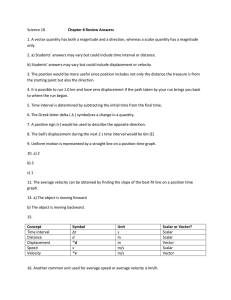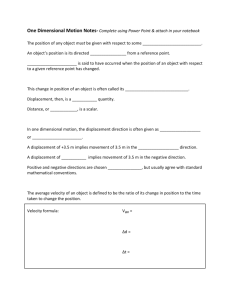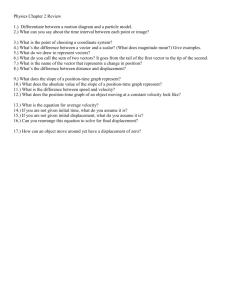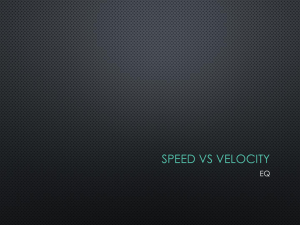PHY 2053 announcements: January 7, 2010 soft cover with white background
advertisement
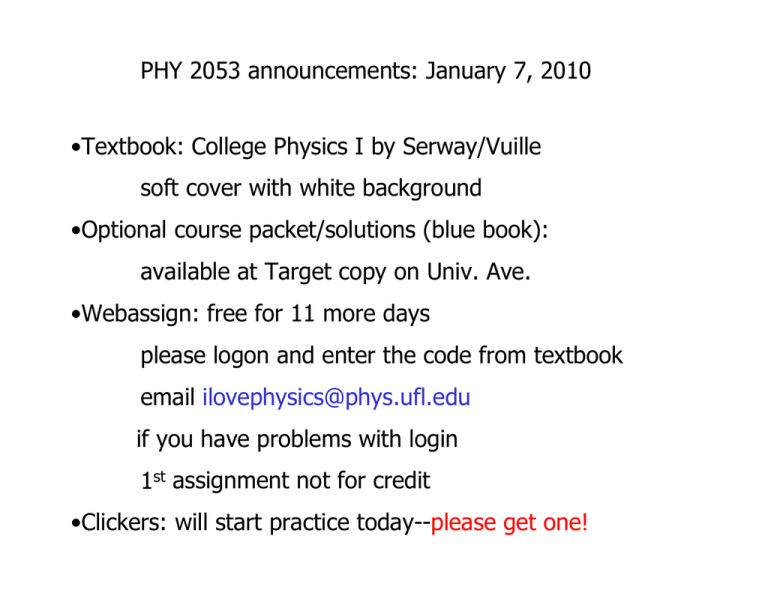
PHY 2053 announcements: January 7, 2010 •Textbook: College Physics I by Serway/Vuille soft cover with white background •Optional course packet/solutions (blue book): available at Target copy on Univ. Ave. •Webassign: free for 11 more days please logon and enter the code from textbook email ilovephysics@phys.ufl.edu if you have problems with login 1st assignment not for credit •Clickers: will start practice today--please get one! Units To convey certain physical property of an object. Units of length: meter, foot, inches, lightyears…. SI -Système Internationale (or MKS=Meters-Kilograms-Second) CGS – Gaussian system (Centimeters-Grams-Second) US Customary (foot-slug-second) you will need a few more defined units in PHY 2054 Units can be treated as algebraic quantities add, subtract, multiply, divide Time remaining = 50 min – 20 min = 30 min Area = width x height = 4 cm x 5 cm = 20 cm2 e.g., SI unit of area: meter2 (m2) SI Unit of speed: meter/second (ms-1) Dimensions Length [L] Mass [M] Time [t] Dimensional Analysis Technique to check the correctness of an equation. Both sides of equation must have the same dimensions 1 hour = 3600 s dimension t on both sides Area = width x height 4 cm x 5 cm = 20 cm2 dimension L2 on both sides HITT RF Remote Login Procedure: (If you have a really old IR remote you do not need to login.) The radio channel number for this room is “07” (zero, seven). It is STRONGLY recommended to login your remote for every class just to be sure it is on the correct radio channel and working before class. 1. 2. 3. 4. PRESS AND HOLD THE DOWN ARROW KEY until the GREEN light on the remote turns RED. PRESS THE “0” KEY and you will see the RED light flash GREEN. PRESS THE “7” KEY and you will see the RED light flash GREEN. PRESS AND RELEASE THE DOWN ARROW KEY again and you will see the red light search for the receiver, if it BLINKS GREEN MULTIPLE TIMES you are logged in. Clicker Quiz #1 Speed measures the distance you travel in a given time. The dimensions of speed are: A. B. C. D. E. L/M2 L/t L·t L2/t L2/(M·t) Significant Figures There is uncertainty in every measurement A significant figure is one that is reliably known All non-zero digits are significant 3.1416 13 13.14 2 significant figures 4 significant figures Significant figures = decimal places Zeros are significant when between other non-zero digits 1004 after the decimal point and another significant figure 1.00 4 significant figures 3 significant figures can be clarified by using scientific notation 1000 1.00 x 103 ? significant figures 3 significant figures Unit Conversions Units can be treated like algebraic quantities that can “cancel” each other See the inside of the text front cover for an extensive list of conversion factors Convert inches to Centimeters: 2.54 cm 15.0 in X 1.00 in =38.1 cm Problem Solving Summary Equations are the tools of physics Understand what the equations mean and how to use them Carry through the algebra as far as possible Substitute numbers at the end Be organized Converting units A sprinter has a maximum speed of 20 miles per hour over a short course. How long does it take her to run 100 m? distance = rate · time time = distance/rate 20 mi 1 h 1.6 km 1000 m m 8.89 h 3600s mi km s 100 m t 11.25s m 8.89 s Clicker Quiz #2 1.000 m=1.094 yard How long in meters is an American football field, which is 100.0 yards long? A. B. C. D. E. 100 m 109 m 109.4 m 91.408 m 91.41 m 100 yd X ( 1.000 m 1.094 yd =91.407678 m ) Chapter 2: Motion in 1D Kinematics: study of motion In kinematics, you are interested in the description of motion Not concerned with the cause of the motion Quantities in Motion Any motion involves three concepts Displacement Velocity Acceleration These concepts can be used to study objects in motion Voyager’s path Robotic surgery Position Choose coordinate axes In one dimension, generally the x- or y-axis Displacement Defined as the change in position x xf xi f stands for final and i stands for initial May be represented as y if vertical Units are meters (m) in SI Graph: position vs time Displacement example x xf xi From A to B xi = 30 m xf = 52 m x = 22 m The displacement is positive, indicating the motion was in the positive x direction From C to F xi = 38 m xf = -53 m x = -91 m The displacement is negative, indicating the motion was in the negative x direction Vector vs. scalar Vector quantities need both magnitude (size) and direction to completely describe them Generally denoted by boldfaced type and an arrow over the letter (x or x ) + or – sign is sufficient for this chapter (for motion in 1 dimension) Scalar quantities are completely described by magnitude only Displacement is a vector. Distance is a scalar. Distance is not the same as displacement. Example: Throw a ball straight up and then catch it at the same point you released it The distance is twice the height The displacement is zero Speed vs. velocity scalar Average speed = = Total distance Total time d t vector Average velocity = Total displacement Total time vaverage x t x f xi t Units: meter/second (m/s) Same average velocity Different speed Average Velocity x vaverage t Constant Velocity The straight line indicates constant velocity The slope of the line is the value of the average velocity Non-Constant Velocity The motion is nonconstant velocity The average velocity is the slope of the blue line joining two points x t Displacement example From A to B xi = 30 m xf = 52 m x = 22 m From A to F xi = 30 m xf = -53 m x = -83 m If the time between successive snapshots is 1 second, Vaverage from A to B = XAB/tAB = 22 m/1s = 22 m/s
